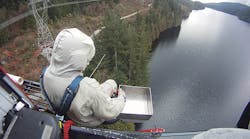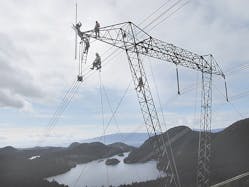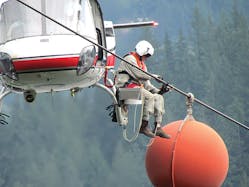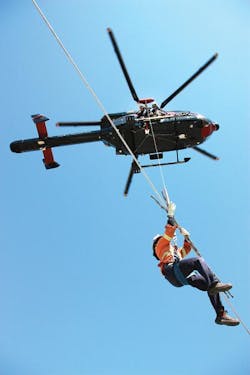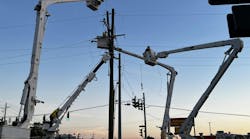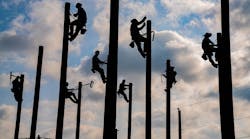Electric utilities have long used helicopters to transport linemen and materials to work sites. Now one Canadian utility is leveraging the capabilities of air travel to perform live-line work on its system.
BC Hydro, a provincial Crown corporation based in Vancouver, British Columbia, trains its journeymen powerline technicians (PLTs) in platform and hoisting methods. As a result of this training, these linemen gain a unique skill set that sets them apart from the rest of the field workforce. The utility no longer needs to rely on outages to perform live-line work, as it can keep its circuits energized, saving time and money, and increasing reliability for its customers without compromising safety of the worker.
Training Technicians
All PLTs can become barehand trained after they have earned their journeymen ticket and spend a year becoming familiar with the transmission system. To earn certification, they must attend a week-long classroom training session sponsored by the trades training department and then complete 90 hours of in-field training.
Once trained, they can maintain their certification by spending 25 hours per year on the wire. Like other utilities practicing barehand, BC Hydro practices live-line work in a variety of ways, including rope access and truck access. In addition to these methods, however, the utility’s technicians also perform live-line work out of a helicopter. BC Hydro offers a variety of training sessions such as hoist to ground, hoist to rescue, and hoist access to stable and unstable plant. A PLT must first be barehand certified and then complete additional training to be able to work on the end of a hoist suspended from a helicopter.
In addition, the pilots and technicians are also trained in hoist methods. They are trained in-house by BC Hydro to work near the energized wire and transport the PLTs safely to their location. For all of the procedures, the PLTs and the helicopter technicians are trained in rescue techniques for situations such as flying into energized wire. The trade training instructors offer a week-long training session for hoisting and platform work once a year, and all the training is tracked for each individual technician.
Working Off an Energized Platform
BC Hydro began developing the platform practice in 2010 and then started using it as a procedure in 2012. In the beginning, the PLTs worked on a 4-ft by 1.5-ft de-energized aluminum platform. The PLTs are attached to the inside of the helicopter, and the platform is attached to the outer skid of the helicopter.
Over time, the utility looked into how to perform work off of the platform without taking lines out of service. To certify that the helicopter could handle the live-line work, BC Hydro put the helicopter on an insulated platform, energized it without a PLT on board and then certified that particular helicopter for energized platform work.
BC Hydro created the platform work practice for live-line work so the PLTs could repair damaged wire on crossings. Many of the utility’s lines cross over rivers in its service territory, and if the conductor is damaged, the PLTs have no way to place a conductor cart on the wire. Instead, they would have to lower the wire down to a barge, repair it and then lift it back into position.
By using a helicopter, the PLTs can conduct a better inspection and perform the repair without lowering the damaged conductor to the ground. The PLTs also can repair conductor from a helicopter using implosive sleeves, which they recently accomplished on a 230-kV crossing in north Vancouver.
Staying Safe in the Air
When the PLTs perform the barehand work from the platform, both the platform and the helicopter become energized. The technicians and the pilots wear barehand suits to protect themselves from the electrical current.
Before the PLTs take off in the helicopter, they are connected by a D-ring anchor point on the back of the helicopter, which prevents them from sliding off. They can’t move further than the platform, and they are fully connected to it with a flight harness on top of their barehand suit. For extra protection, they wear a seat belt.
Using this work method, the PLTs perform mid-span work on spacers and marker balls, and repair conductor and conduct visual inspections on inaccessible towers.
BC Hydro discovered that it was too challenging for one pilot to fly the aircraft and watch the wire with a PLT on board, so the utility requires two pilots for added safety during platform operation.
Practicing Hoisting Methods
The PLTs also have the opportunity to move to the next level by using the hoisting method for barehand work. This barehand method is examined for each job task and approved by work methods prior to approval. BC Hydro developed the hoisting method because the PLTs couldn’t reach all of the wire on a platform because of the rotor clearance to the conductor.
For that reason, BC Hydro began using the hoisting method last year to change marker balls and spacers on river crossings, which were becoming increasingly impossible to arrange for outages.
For most operations, the utility relies on a twin-engine helicopter, which can fly low and slow and hover near the power lines and towers. BC Hydro often uses an A Star 355 helicopter for platform work and a Bell 212 or MD902 for the hoisting method. Unlike the A-Star 355, the Bell 212 and MD902 do not become energized, the utility instead began inserting a 20-ft section of barehand rope into the hoist line. That way, the PLT can hoist down to the work location, and the barehand rope insulates the worker from the helicopter while he or she is working live.
When performing a barehand operation with a hoist method, two hoist technicians go with the pilot and PLT in the helicopter. One of the hoist technicians raises and lowers the PLT, while the other ensures that everything is properly connected inside and outside of the helicopter during the operation.
As a result of the barehand work, BC Hydro has been able to safely complete its work and save time in the field. In the past, it would take three weeks to finish five different sites, but by using the helicopters, the PLTs can finish them in one day. The utility can simply fly its PLTs into a location where there is damaged conductor, lower them into position, allow them to perform the repair, and then bring them back up into the helicopter and fly them back to the yard.
While BC Hydro and other utilities across North America have used helicopters for line work for decades, the utility has been able to ramp up its productivity by performing live-line work from the air. Through hoisting and platform methods, the PLTs can safely and quickly make repairs, install parts and inspect the infrastructure.
Devin Dukeshire ([email protected]m) is a field operations manager for transmission field operations for BC Hydro. Based in Vancouver, Canada, the lower mainland division is responsible for operating and maintaining the transmission system from 69 kV to 500 kV, responding to emergencies and upgrading the transmission system.
Companies mentioned:
BC Hydro | www.bchydro.com
Bell | www.bellhelicopter.com
Star | www.star-helicopters.com
Sidebar: How to Perform Barehand Hoist Work from a Helicopter
1. The managers call into the aircraft operations department to get preapproval for the helicopter to take flight. They look at weather conditions and also ensure that the helicopter is right for the task at hand. They then either give the field crew the approval to fly or deny the request.
2. The helicopter company and crew foreman perform a reconnaissance flight to check out the conditions for the day’s job.
3. The pilot flies the helicopter back to the yard and tailboards with the crew.
4. The crew double-checks barehand suits and confirms it has all the personal protective equipment necessary for the barehand job.
5. The power line technician (PLT) puts on his or her harness and does a walk through with the hoist technicians, the pilot and the foreman.
6. The lineman is then lifted up from the ground already in the hoist with the barehand rope in place. This PLT will give the pilot a hand sign or radio signal to raise or lower the rope. If the PLT is changing out a marker ball, he or she will need to take off the old ball, fly back to the yard, pick up the new one, and then put it into position.
7. Alternatively, if the PLT is not performing work energized, then he or she can repel out of the helicopter to perform repair work on a tower or line.
